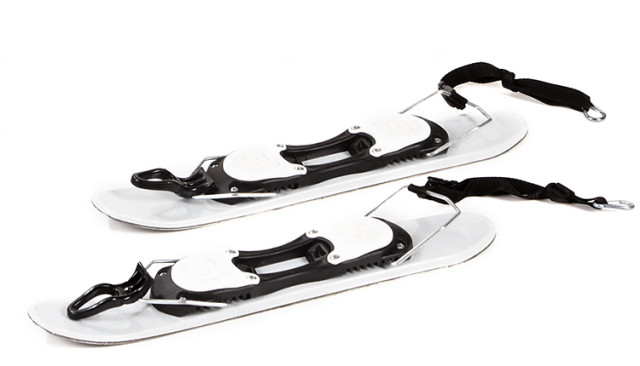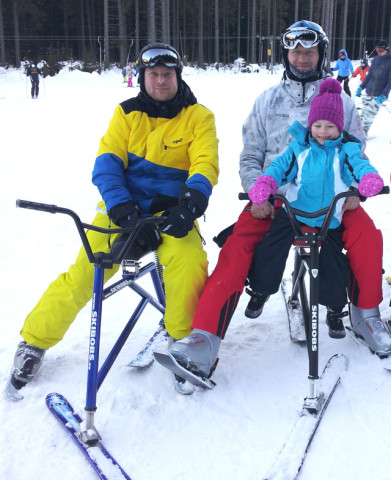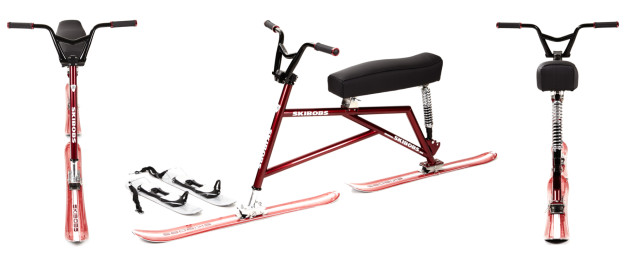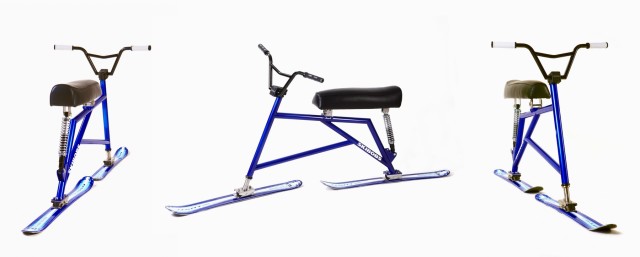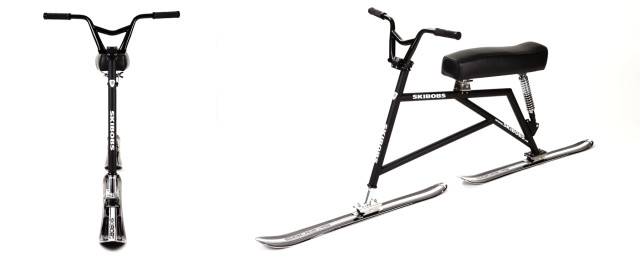In diesem Abschnitt werden wir uns bemühen, Ihre meist gestellten Fragen bezüglich der Skibobs zu beantworten.
1. Wie einen Skibob auswählen?
Eine wichtige Rolle bei jedem Kauf spielt zweifelsohne der Preis. Bei Kauf eines Skibobs ist es aber nicht weniger wichtig, auch weitere Kriterien zu berücksichtigen, um einer Enttäuschung vorzubeugen, die nach der ersten gefahrenen Saison eintreten könnte.
Robustheit und Festigkeit des Rahmens
Dies ist die Grundvoraussetzung für eine sichere Fahrt, weil es gerade der Rahmen ist, der bedeutend die Fahreigenschaften des Skibobs als Ganzes beeinflusst. Wenn sich der Skibob während der Fahrt unter Ihnen wellen und drehen wird, werden Sie sich nicht sicher fühlen und somit auch nicht die technischen Möglichkeiten des Skibobs völlig nutzen. Dieses Problem kann bei Herstellern eintreten, die sich bemühen, das Gewicht des Skibobs um jeden Preis zu senken. Um dieses Ziel zu erreichen, nutzen sie beispielsweise zu sehr dünne nicht verschweißte Rohre für die Konstruktion ihrer Rahmen, verschiedene Schnellverbinder aus Kunststoff und Kunststoffkomponenten. (Die Hersteller von Rennskibobs werden sich bemühen, das Gewicht des Skibobs so weit wie möglich dem Grenzwert von 23 kg anzupassen. Die Hersteller von Freizeitskibobs gehen dagegen von der Voraussetzung aus, dass es einem Freizeitfahrer nicht direkt nur um die Überwindung eines Geschwindigkeitsrekords oder dieser oder jenen Skipiste sondern eher um die Freude an der Fahrt und den Komfort bei der Handhabung des Skibobs geht. Daher bemühen sie sich, das Gewicht so weit wie möglich zu reduzieren.) Es ist jedoch erforderlich, einen geeigneten Kompromiss zwischen dem Gewicht, der Ermüdungsfestigkeit (Lebensdauer) und der Steifigkeit des Rahmens zu finden. Neben der Konstruktion selbst und der Rahmengeometrie kommt es selbstverständlich auch auf das Material an, aus dem der Rahmen hergestellt ist, denn die einzelnen Materialien unterschieden sich voneinander nicht nur in dem Gewicht sondern insbesondere auch in den physikalischen Eigenschaften.
Da eine gewisse Ähnlichkeit zwischen dem Fahrrad und dem Skibob besteht, können Sie bei verschiedenen Skibobmarken an Rahmen antreffen, die aus denselben Materialien hergestellt sind, die auch im Radfahrsport verwendet werden.
Hi-Ten Stahl – Heute finden wir diesen Stahl nur noch bei den billigsten Rahmen. Hi-Ten Stahl ist fest, aber gleichzeitig sehr schwer. Die aus diesem Stahl hergestellten Rahmen sind ziemlich korrosionsanfällig und zwar auch trotz der erforderlichen Oberflächenbehandlung.
Duralumin – So werden verschiedene Aluminiumlegierungen bezeichnet. Das Aluminium selbst ist sehr weich, daher müssen für die Herstellung von Rahmen seine Legierungen verwendet werden. Duralumin ist ungefähr dreimal leichter als Stahl. Es ist jedoch auch weniger fest. Um eine gleiche Festigkeit wie bei Stahlrahmen zu erreichen, müssten die Rohre dreimal stärker sein, was eine Erhöhung des Gewichts zur Folge hätte. Daher werden für die Herstellung von Rahmen Duraluminrohre mit einem größeren Durchmesser, bzw. abgeflachte Rohre verwendet, wodurch eine Festigkeit, die sich der Festigkeit eines Stahlrahmens nähert, unter der Erhaltung eines niedrigen Gewichts erreicht wird. Einen großen Nachteil des Duralumins stellt jedoch die Tatsache dar, dass das Duralumin relativ brüchig ist und dass es in ihm mit der Zeit durch wiederholtes Beanspruchen zu strukturellen Änderungen kommt, die einen Bruch zur Folge haben. (Daher überwiegen beispielsweise im Bereich der BMX Fahrräder und der Freestyle BMX Fahrräder immer noch Rahmen aus Cr-Mo Stahl.)
Gegenwärtig werden die Aluminiumrahmen der Fahrräder überwiegend aus zwei Legierungen hergestellt – Legierungen 6061T6, 7020T6, bzw. 7005T6. (7005T6 ist der 7020T6 ähnlich, die sich unwesentlich in der chemischen Zusammensetzung unterscheidet. Das Zeichen T6 bezeichnet die Weise der Wärmebehandlung. Konkret bei der Bezeichnung T6 handelt es sich um das Lösungsglühen und die natürliche Alterung, oder das Erhöhen der Härte auf eine maximale Festigkeit.) 7020T6 erreicht viel höhere Festigkeitswerte gegenüber 6061T6 (ca. um 20 %).
Die aus der Legierung 7020T6 hergestellten Rohre sind nach der Herstellung durch das Ziehen thermisch zu behandeln, um die innere Spannung zu lockern. Dies wird durch das Lösungsglühen und die natürliche Alterung durchgeführt. Das Lösungsglühen wird gewöhnlich bei Temperaturen von 450 °C bis 575 °C über eine Dauer von ungefähr 6 bis 10 Stunden durchgeführt und es sollte mit einer schnellen Abkühlung beendet werden. Anschließend beginnen die Rohre bei einer Raumtemperatur unter einem allmählichen Anstieg der Festigkeit natürlich zu altern (aushärten), und zwar zunehmend mit der Dauer, die nach ihrem Lösungsglühen vergeht. Die natürliche Alterung ist bei der Legierung 7020T6 ebenfalls nach dem Schweißen durchzuführen. Beim Schweißen kommt es zu einer Erwärmung der Rohre im Bereich der Schweißstelle, wodurch es zu strukturellen Änderungen kommt, die eine Änderung der mechanischen Eigenschaften (Aufweichen und Reduzierung der Festigkeit) zur Folgen haben. Damit das Material seine ursprünglichen, durch die Norma garantierten Eigenschaften zurück gewinnt, muss es bei einer Raumtemperatur natürlich altern lassen. Innerhalb von den ersten sieben Tagen nach dem Schweißen erwirbt das Material 90 % der Festigkeit, die restlichen 10 % erwirbt es dann innerhalb von zwei bis drei Wochen nach dem Schweißen, und zwar bei der Umgebungstemperatur. Dies hat Vorteile nicht nur bei der Herstellung des Rahmens, sondern auch beim anschließenden Service nach der Garantiefrist im Falle von Reparaturen.
Die Legierung 6061T6 erwirbt die ursprünglichen mechanischen Eigenschaften nach dem Schweißen durch die natürliche Alterung, indem der Prozess der Rückkehr auf die ursprünglichen mechanischen Eigenschaften durch das Erwärmen zu erreichen ist. Der Schweißteil ist bei der vorgeschriebenen Temperatur und unter der Einhaltung der Dauer (z.B. bei 170 °C bis 180 °C innerhalb von 8 Stunden) künstlich altern zu lassen, um die verlangten Festigkeitsgrenzen zurück zu erreichen. Der Prozess der künstlichen Alterung ist energetisch sowie zeitlich anspruchsvoll und es sind die vorgeschriebenen Werte und Zeiten einzuhalten. Diese Eigenschaft der Legierung 6061T6 beschränkt anschließend auch die Reparaturen der Rahmen aus dem Grund der Nichterreichbarkeit der Anlage für den Prozess der künstlichen Alterung.
Cr-Mo Stahl – Teurere Rahmen werden heute aus dem Chrom-Molybdän-Stahl hergestellt. Sie werden aus Rohren von einer doppelten Wanddicke (sog. Double Butted) geschweißt, wobei im mittleren Teil des Rohres die Wanddicke dünner und an den Rändern, wo das Rohr mehr beansprucht wird, im Gegenteil stärker ist. Die Rahmen aus dem Cr-Mo Stahl sind steifer und sie nehmen die Unebenheiten des Geländes besser als die Aluminiumrahmen auf. Ebenfalls auch die Ermüdungsfestigkeit ist beim Cr-Mo Stahl deutlich besser als beim Duralumin. Einen geringen Nachteil stellt das etwas höhere Gewicht dar, obwohl ein gut ausgeführter Rahmen mit seinem Gewicht dem Duraluminrahmen mutig konkurrieren kann.
Karbon – Das Kohlenstoff-Kompositmaterial ist fünfmal leichter als Stahl und es verfügt über eine sechsmal höhere Festigkeit. Es absorbiert ausgezeichnet Vibrationen. Es hat eine fast Null-Ermüdungskurve, was, laienhaft gesagt, bedeutet, dass das Material fast gar nicht altert und es sollte daher nicht in Folge von einem Bruch ausdienen.
Jedoch auch Karbon hat seine Nachteile. Einer von ihnen ist der hohe Preis. Der zweite und viel erheblicher Nachteil ist die Tatsache, dass es bei der Herstellung von Karbonrahmen sehr wichtig ist, in welcher Richtung die Fasern geführt werden, ihre Anzahl, in welchem Verhältnis das Kohlenstoffgeflecht und das Harz ist, das als ein Materialbindemittel dient, oder die Anzahl der Geflechtsschichten. Das alles bestimmt, wie und in welchen Teilen der Rahmen elastisch und Fest sein wird. Die Richtung der Kohlenstofffasern im Rahmen legt auch seine Beständigkeit gegen Stöße fest. Obwohl wir bereits anführten, dass Karbon eine fast Null-Ermüdungskurve hat, stellt die größte Schwäche des Karbons die Verletzlichkeit seiner Oberfläche dar. Die Rahmen aus Karbon sind relativ empfindlich gegen eine mechanische Beschädigung, und sofern ein Stoß von einer anderen Richtung kommt, als für die der Rahmen konstruiert wurde, muss es der Rahmen nicht überleben. Eine typische Situation ist das Treffen des Rahmenrohres durch einen weggeschleuderten Stein oder ein seitlicher Stoß. Bei so einer Beschädigung ist das Karbon eigentlich nicht reparierbar.
Und da das Risiko, dass Sie bei Ihrer Fahrt den Skibob umkippen, viel höher als bei einem Fahrrad ist, sind wir der Meinung, dass das Karbon kein geeignetes Material für den Skibobrahmen ist.
Titan – Titan wäre ein völlig ideales Material für unsere Zwecke. Ein titanrahmen ist sehr leicht, wobei sich seine Festigkeit dem Stahl nähert. Er ist gegen Korrosion und die Ermüdung des Materials beständig. Titan verfügt insbesondere über die Fähigkeit der Stoßaufnahme sowie über ein Formgedächtnis, was seine größten Vorteile sind. Sofern sich der Rahmen durch einen Stoß leicht verbiegt, kehrt er oft in seine ursprüngliche Lage zurück, ohne dass an der Stoßstelle eine Verbiegung bleibt. An einem titanrahmen gibt es einfach keine durcheinandergebrachten Strukturen oder gebogene Rohre. Sofern es zu einem starken Anprall kommt und der Rahmen beispielsweise von einem Auto überfahren wird, dann gibt es nur zwei Möglichkeiten: entweder ist der Rahmen völlig vernichtet oder er hält aus. Titan ist jedoch sehr teuer und bearbeitungsaufwendig. Die kleinen Werkstätten können sich die Spitzentechnologie nicht leisten. Die Vorbereitung ist arbeitsintensiv, teuer und oft erfordert sie auch eine mehrjährige Forschung. Diesem hat auch das Hinterland zu entsprechen. Bei der Arbeit mit Titan ist die komplizierte technologische Vorgehensweise exakt einzuhalten. Daher werden die Titanrahmen nur von wenigen Firmen hergestellt, die die Arbeit mit diesem Material beherrschen. Die meisten Hersteller nutzen ihre Kenntnisse, die sie bei der Arbeit in der Flugzeugindustrie gewannen. Man kann sagen, dass die Erfahrungen des Herstellers ein entscheidender Faktor für die Endqualität des Titanrahmens sind. Die Rahmen werden in der Regel auf Bestellung, manuell und in kleinen Serien hergestellt, daher ist ihr Preis sehr hoch.
Auf Grund der oben beschriebenen Eigenschaften der einzelnen Materialien und unter Berücksichtigung der Tatsache, dass der Skibob am meisten einem BMX-Fahrrad ähnlich ist, entschieden wir uns, die Rahmen für unsere Skibobs aus dem Cr-Mo Stahl herzustellen.
Einstellbare Federung je nach dem Gewicht des Skibobfahrers
Ähnlich wie bei den Fahrrädern ist die Federung ein wichtiger Bestandteil eines Skibobs. Es gibt Hersteller, die sich anstellen, dass eine Einstellung der Federung (eine Steifigkeit) völlig befriedigend ist. Aber denken Sie wirklich, dass eine gleiche Federungssteifigkeit sowohl einer Frau, die 57 kg wiegt, als auch einem 100 kg wiegenden Mann entsprechen wird? Die meisten Gas-, Öl- oder Luftdämpfer ermöglichen wenigstens eine mehrstufige Federungssteifigkeit. Sofern aber die Dämpfung mit Hilfe von einem Gummi-Silentblock (Feder) ausgeführt ist, kann die Federungssteifigkeit nicht eingestellt werden. Sie ist einfach festgelegt, ohne Berücksichtigung Ihres Gewichts und Bedarfs.
Wartungskosten
Die einfache und robuste Konstruktion des Skibobs garantiert minimale Ansprüche an die Wartung sowie an den Service. Je mehr komplizierte Mechanismen oder Kunststoff- oder Gummiteile, die bruchanfällig sind, desto höhere Kosten für ihre Reparatur. Ersatzteile können sicher gekauft werden, aber für welchen Preis?
Vorsicht auf Bastler
In der letzten Zeit kamen im Internet Angebote von verschiedenen selbst ernannten Bastlern und Herstellern, die in Garagen arbeiten, vor, die eine Einzelfertigung von Skibobs nach Maß anbieten. (Dieses Problem betrifft jedoch auch Amateurfans, die eine Herstellung von verschiedenen Liegerädern, speziellen Bikes oder rollern anbieten.) Neben der Tatsache, dass der Preis für solche Erzeugnisse viel höher als der Preis für unsere Produkte ist und in einer Reihe von Fällen kommt er sogar auch dem Preis für eine Spitzenrennmaschine gleich, möchten wir gerne auch auf einige damit verbundene Risiken aufmerksam machen. Insbesondere handelt es sich um die Nichteinhaltung der festgelegten Vorgehensweisen bei der Herstellung. Die meisten Amateurhersteller machen Fehler gleich am Anfang des Herstellungsprozesses, indem sie ein ungeeignetes Material für die Rahmenherstellung wählen. Zu diesem Schritt werden die Bastler oft dadurch gezwungen, dass der Kauf von stückweise verlangten Rohren aus geeignetem Material, wie Cr-Mo 4130, Al 7020T6 oder Al 6061T6, in der heutigen Zeit sehr kompliziert ist. In den meisten Fällen muss dieses Material in Asien bestellt werden, wohin ihre Produktion die meisten bedeutenden Hersteller auf dem Gebiet des Fahrradsportes verlagerten, und zwar in einer Menge, die sich ein gelegentlicher Hersteller finanziell nicht leisten kann. Daher greifen die meisten dieser Hobby-Hersteller auf verschiedene Alternativen zurück. Sie wählen oft aus Not Rohre entweder aus völlig üblichem Stahl oder aus einer ungeeigneten Aluminiumlegierung, die mit ihren mechanischen Eigenschaften den Anforderungen an einen Skibob nicht entspricht. Daraus ergeben sich anschließend weitere Fehler in der Herstellung, insbesondere im Bereich des Schweißens. Beim Schweißen von Aluminium, Edelstahl oder Cr-Mo Stahl ist im Allgemeinen die korrekte technologische Vorgehensweise einzuhalten, was anspruchsvoll ist. Es sind die korrekte Vorwärmweise, die Schweißparameter, die anschließende Härtungsweise, etc. einzuhalten. Ein Schweißer muss für das Arbeiten mit diesen Materialien über ausreichende Erfahrungen verfügen, und es ist am besten, wenn die Arbeit mit einem konkreten Material seine Haupttätigkeit ist. Anderenfalls ist dann das Ergebnis nicht befriedigend.
Es gibt auch nicht wenige Fälle, dass ein solcher Fan im Großhandelslager das erste Duraluminrohr kauft, das ihm gefällt und das ihm unter die Hände kommt, ohne dass er die exakte Zusammensetzung dieser Aluminiumlegierung kennt, und unter diesen Aspekten beginnt er mit dem Bau seiner Maschine. Die zugeschnittenen Rohre bringt er dann seinem Bekannten, der dieselbe Amateurbegeisterung wiederum auf dem Gebiet des Schweißens teilt. Das Ergebnis sind dann unschöne Schweißstellen, ein Material, das nicht durchschweißt oder im Gegenteil durchbrennt wird, oder eine Versprödung des Materials im Bereich der Schweißstelle, etc. So ein begeisterter Mensch zögert dann nicht und fotografiert sein, mit einem Riesengewicht voll beladenes Werk aus, um der ganzen Welt nachzuweisen, was für ein tolles Produkt er herstellte. Dabei macht er sich gar nichts daraus, dass die Fotografie, auf der sein Rahmen einer riesigen statischen Belastung widersteht, zwar auf den ersten Blick effektvoll ist, aber nichts davon aussagt, wie der Rahmen auf die dynamische Belastung und die zyklische Beanspruchung reagieren wird, was ein wesentlich wichtiger Aspekt ist.
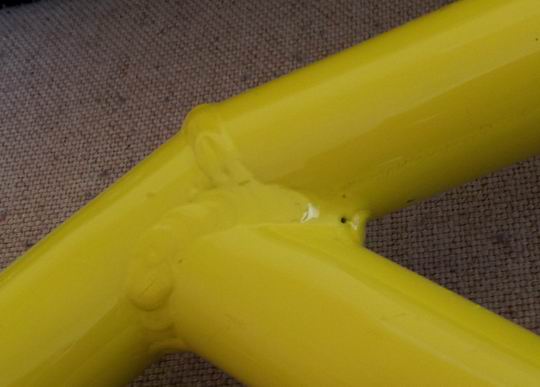
Also auf diese Weise bestimmt nicht!
Ein weiterer Missstand, dem wir bei kleinen Herstellern begegnen können, ist eine falsche Befestigungsweise der Skier. Auch hier können wir den Grund dafür darin sehen, dass ein kleiner Hersteller schwer an das erforderliche Material kommt, in diesem Fall an Originalschrauben für die Skibindung. Und so wird wieder improvisiert. Das Ergebnis können wir am Bild sehen, wo die Bindung mit selbstschneidenden Schrauben befestigt ist, die durch die Lauffläche der Skier führen. Nicht nur dass durch diese Befestigungsmethode die Lauffläche selbst beschädigt wurde, sondern es wurde auch die Skier geschwächt und die Skier platzte bei einem Auffahren auf eine kleine Unebenheit, die die Skier bei der Einhaltung der korrekten technologischen Vorgehensweise schaffen würde.
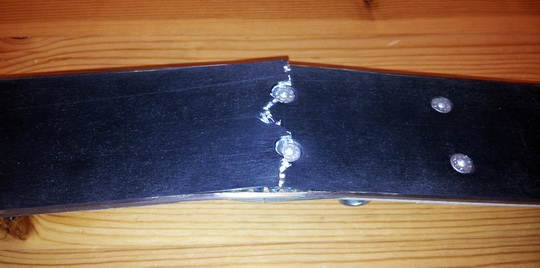
Reines Dilettantentum
Zu den weiteren Mängeln bei den Amateurherstellern gehören beispielsweise eine falsche Rahmengeometrie, eine schlechte Qualität der Endbearbeitung, eine schlechte Sitzbankqualität (Material sowie die Ausführung), billige „no-name“ Skier…
Selbstverständlich wollen wir nicht alle kleine Hersteller „in einen Sack werfen“, aber man sollte vorsichtig sein. Es geht vor allem um Ihre Sicherheit und Ihre Gesundheit.
2. Soll ich mir originelle Fußskier kaufen?
Die Fußskier, die der Fahrer angeschnallt hat, helfen ihm dabei, die Stabilität auf dem Skibob zu erhalten. Die Miniskier gehören nach den Regeln FISB zu der Pflichtausrüstung des Skibobfahrers (übrigens ohne Miniskier können Sie wohl kaum auf den Berggipfel mit Hilfe von einem Skilift fahren). Diese Fußskier können an die meisten klassischen Skischuhe angeschnallt werden. Die Länge unserer Fußskier beträgt 55 cm, die Breite 88 mm. Diese Skier haben keine Taillierung, und daher sind sie völlig gerade. Es handelt sich wieder um Profi-Fußskier, die von unserer Nationalmannschaft genutzt werden. Der Preis für unsere Fußskier beträgt 2.500 CZK
Wir wissen, dass einige unsere Kunden anstatt der originellen Fußskier ältere Abfahrtsskier nutzen, die sie einfach durch ein Abschneiden verkürzen und die Skibindung anmontieren. Selbstverständlich können wir unsere Kunden nicht zwingen, unsere originellen Fußskier zu kaufen, aber wir sind davon überzeugt, dass sich die Investition von 2.500 CZK mehr als lohnen wird. Nehmen Sie bitte in Betracht, dass die originellen Fußskier keine Taillierung haben. Dies ist deshalb, weil sie sich während der Fahrt neutral verhalten sollen, weil die Skibobskier bereits einen Radius haben. Wenn also jemand nur die Abfahrtsskier verkürzt (selbstverständlich meinen wir die Carving-Skier), dann haben diese schon ihre größere oder kleinere Taillierung und sie verhalten sich somit bei der Fahrt nicht mehr neutral. Auch wenn es Ihnen gelingt, in einem Basar die älteren klassischen Abfahrtsskier ohne Taillierung zu kaufen, dann gibt es hier einen weiteren sehr wichtigen Grund dafür, warum sich die originellen Fußskier anzuschaffen. Der Grund ist ihre Dicke von 14 mm in der ganzen Skilänge (55 cm). Daher halten diese Skier eine sehr große Belastung aus. Dagegen nimmt die Dicke bei den Abfahrtsskiern in der Richtung zur Spitze bedeutend ab, oft bis auf eine Dicke von nur 7 mm. Es ist daher klar, welche Skier mehr aushalten.
